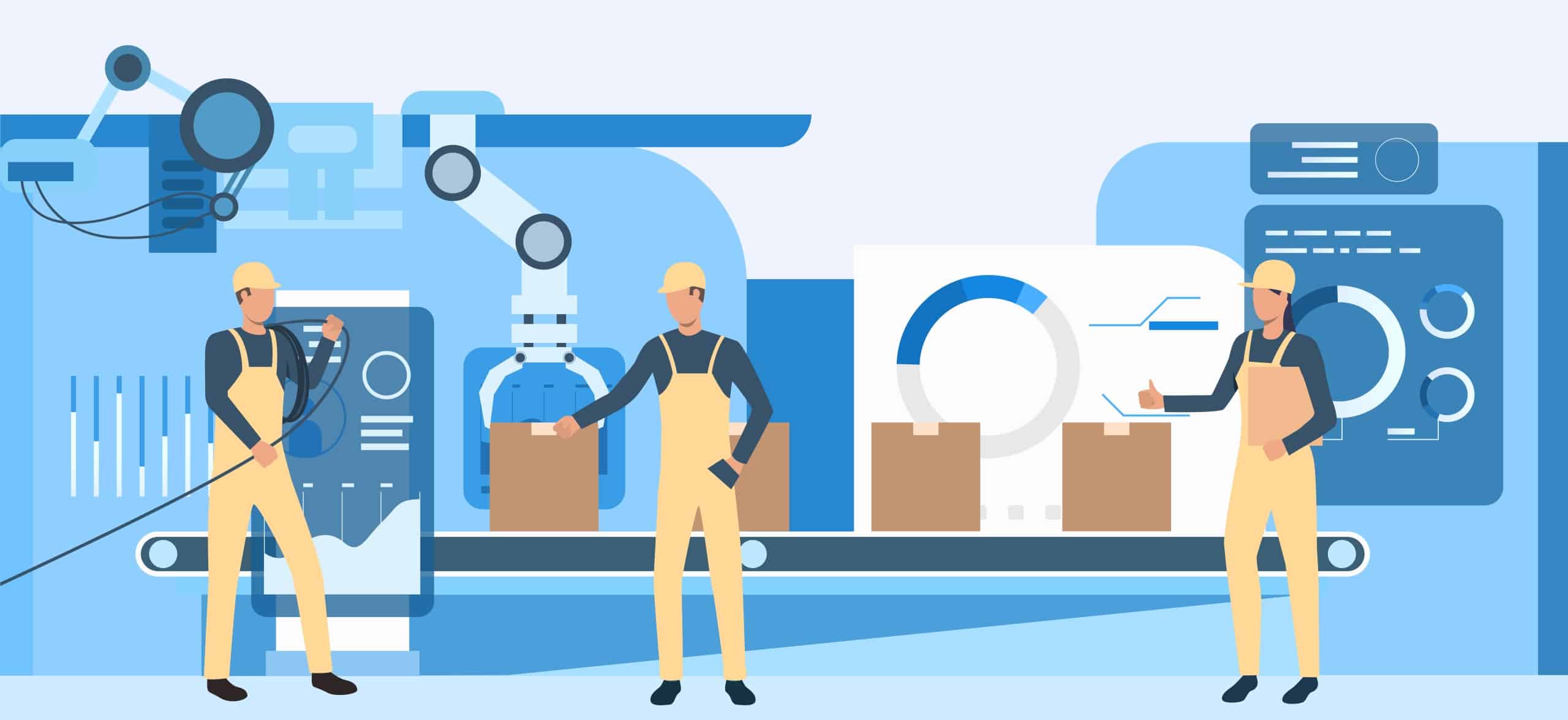Automated Production Lines
Automated production lines are revolutionizing the wet wipes manufacturing sector by greatly improving efficiency and decreasing labor expenses. These production lines employ a fusion of robotics, conveyor systems, and sophisticated software to optimize the production process from beginning to end. Automation guarantees that every step of the production process, including the cutting and folding of the wipes and their packing, is executed with accuracy and uniformity. This not only enhances manufacturing efficiency but also reduces human mistakes, resulting in superior quality products and fewer faults.
Automated production lines not only enhance efficiency but also provide the capability to promptly adjust to evolving market requirements. Advanced robotics and software systems may be reprogrammed efficiently to manufacture several kinds of wet wipes with no interruption in production. This capability is especially beneficial in an industry where product diversity and customization are crucial competitive advantages. Wet wipes manufacturers can quickly transition from manufacturing baby wipes to generating disinfecting wipes to cater to the distinct requirements of various consumer segments. Wet wipes manufacturers gain a clear advantage by being able to promptly adapt to market movements and consumer preferences without the need for extensive manual intervention.
Furthermore, the incorporation of automation in manufacturing processes leads to cost benefits that go beyond simply reducing labor expenses. Automated methods enhance the utilization of raw materials, minimizing wastage and guaranteeing effective resource allocation. Moreover, these systems can function constantly without any interruptions, resulting in increased production quantities and reduced costs per unit. Although the upfront cost of implementing automation technology may be significant, the long-term advantages in terms of enhanced efficiency, reduced operational expenses, and enhanced product quality justify the investment. By adopting automation, wet wipes manufacturers can improve their competitiveness and attain sustainable growth in a sector that is sensitive to costs.
Smart Inventory Management
Implementing intelligent inventory management is a crucial advancement for wet wipes manufacturers seeking to streamline their supply chain and minimize expenses. Smart inventory management utilizes sophisticated data analytics, live monitoring, and predictive algorithms to ensure the maintenance of ideal stock levels. Wet wipes manufacturers can have real-time visibility into their inventory by employing IoT sensors and automated tracking systems. This enables them to ensure the constant availability of wet wipes raw materials and finished products as required. This minimizes the potential for excessive inventory, which can result in the immobilization of funds and occupation of storage facilities, or shortages, which can disrupt production and result in missed sales opportunities.
An important benefit of smart inventory management is its capacity to precisely predict demand. Through the examination of past sales data, industry patterns, and external influences such as seasonal fluctuations or promotional campaigns, these systems can accurately forecast future demand. This allows wet wipes manufacturers to strategically organize their procurement and production schedules, ensuring that inventory levels are in sync with projected market demands. In addition, predictive analytics can detect patterns and abnormalities that may suggest possible disruptions in the supply chain, enabling firms to take early actions to reduce risks.
Integrating intelligent inventory management also promotes improved supplier relationships and boosts overall efficiency in the supply chain. Accurate information regarding inventory levels and rates of consumption allows wet wipes manufacturers to enhance their collaboration with suppliers, ensuring prompt delivery and facilitating more favorable negotiations. Automated reorder systems can initiate purchase orders when specific criteria are met, thereby minimizing administrative tasks and guaranteeing a smooth and uninterrupted flow of materials. In addition, intelligent inventory systems can seamlessly connect with other enterprise resource planning (ERP) systems, offering a comprehensive perspective of the wet wipes manufacturing process and facilitating well-informed decision-making. By using intelligent inventory management, manufacturers of wet wipes can attain higher operational efficiency, decrease expenses, and improve their capacity to immediately meet consumer demand.
Energy-Efficient Machinery
Energy-efficient technology is essential for wet wipes manufacturers aiming to decrease operational expenses and improve sustainability. These sophisticated wet wipes machines are engineered to minimize power consumption while simultaneously maintaining or enhancing production efficiency. Wet wipes manufacturers can achieve substantial reductions in their energy expenses by implementing energy-saving technology such as variable frequency drives, high-efficiency motors, and optimized control systems. For example, wet wipes machines that are equipped with variable frequency drives can modify their energy consumption according to the present load needs. This helps to avoid using needless energy during stages of reduced production.
Energy-efficient gear has advantages that go beyond just cost reductions. Additionally, these wet wipes machines aid in achieving a company’s environmental objectives by diminishing the overall carbon footprint. With the increasing worldwide awareness of environmental issues, both customers and regulatory organizations are placing greater emphasis on wet wipes manufacturers adopting greener practices. Allocating resources towards energy-efficient equipment showcases a company’s dedication to environmental stewardship, thereby bolstering its brand image and fostering consumer loyalty. In addition, energy-efficient wet wipes machines frequently include contemporary technologies that enhance process control, minimize waste, and improve overall production quality, so further magnifying the advantages.
Implementing energy-efficient wet wipes machines is also in line with the wider movement towards intelligent production and Industry 4.0. These wet wipes machines are frequently combined with sophisticated monitoring and control systems that offer up-to-the-minute information on energy usage and machine efficiency. Analyzing this data allows for the identification of patterns and areas that need improvement, facilitating the ongoing optimization of the production process. In addition, numerous energy-efficient machines are specifically engineered to be compatible with renewable energy sources, such as solar or wind power. This enables wet wipes manufacturers to further diminish their dependence on conventional energy supply. By allocating resources to energy-efficient technology, wet wipes manufacturers can simultaneously reduce operational expenses and gain a competitive advantage in a market that is progressively prioritizing sustainability and efficiency.
Waste Reduction Technologies
Waste reduction methods are crucial for wet wipes businesses seeking to reduce expenses and improve environmental sustainability. These technologies include a range of tactics and improvements aimed at maximizing the efficiency of raw material usage, minimizing scrap and rework, and reducing expenses associated with waste disposal. An effective strategy involves the utilization of precision cutting and material optimization tools. These technologies guarantee that each wet wipe is precisely cut and shaped, minimizing the quantity of extra material used. This maximizes the utilization of each fabric roll and decreases the manufacturing waste generated.
Another notable progress in trash reduction is the implementation of closed-loop recycling systems. These systems enable wet wipes manufacturers to reuse water and other industrial inputs, thereby decreasing the need for new resources and minimizing the quantity of waste that requires treatment or disposal. As an illustration, water utilized in the manufacturing procedure can be subjected to filtration, treatment, and subsequent reuse, resulting in a substantial reduction in both water usage and the generation of wastewater. Similarly, remnants of fabric and pieces that have been cut off can be gathered, treated, and incorporated back into the manufacturing process, transforming potential refuse into valuable resources.
Data analytics is essential for waste reduction, alongside these technical alternatives. Wet wipes manufacturers can obtain valuable insights into their wet wipes manufacturing processes and pinpoint areas of waste generation by employing real-time data monitoring and analytics. By utilizing a data-driven strategy, organizations can effectively implement specific enhancements, such as fine-tuning machine configurations, simplifying operational processes, or optimizing inventory management to minimize spoilage. Predictive analytics can anticipate future problems in advance, therefore enabling proactive actions to be performed and preventing wastage. Waste reduction solutions benefit wet wipes manufacturers by reducing their operational expenses and supporting their sustainability activities. This makes them more appealing to environmentally concerned consumers and partners.
Predictive Maintenance
Predictive maintenance is an innovative strategy that wet wipes manufacturers can use to improve the dependability of their equipment, minimize periods of inactivity, and decrease expenses related to maintenance. This approach depends on sophisticated sensors, Internet of Things (IoT) devices, and data analytics to continuously monitor the state of machinery in real time. Predictive maintenance systems can detect early indicators of wear and probable problems by consistently gathering and evaluating data on vibration, temperature, pressure, and other crucial characteristics. This enables maintenance personnel to proactively resolve faults before they progress into expensive breakdowns, therefore assuring smoother and more efficient production operations.
A key advantage of predictive maintenance is the capacity to carry out maintenance tasks just when they are required, rather than following a predetermined timetable. By adopting a condition-based maintenance approach, the occurrence of needless maintenance activities is prevented, resulting in reduced labor and parts costs, as well as an extended lifespan of equipment. For example, when a sensor detects unusual vibrations in a cutting machine, maintenance can be arranged to specifically address the problem, thus preventing a total machine breakdown. This focused intervention aims to minimize any disturbances to the production line, ensuring that productivity remains at a high level and reducing any instances of unexpected downtime.
Predictive maintenance also enhances safety and ensures compliance. Wet wipes manufacturers can avert dangerous circumstances that could jeopardize personnel or result in regulatory infractions by proactively identifying probable failures. In addition, the precise data gathered by predictive maintenance systems can assist firms in maintaining thorough maintenance records, showcasing adherence to industry norms and regulations. Utilizing predictive analytics and machine learning models enhances the precision of maintenance predictions, consistently enhancing the efficiency of the system as time progresses.
Overall, predictive maintenance is a highly beneficial tool for wet wipes manufacturers, providing substantial cost reductions, increased operational effectiveness, and enhanced safety measures. Through the utilization of real-time data and sophisticated analytics, businesses may transition from a reactive or scheduled maintenance strategy to a more proactive approach, guaranteeing optimal and dependable operation of their equipment. This not only decreases the overall cost of owning machinery but also promotes a more environmentally friendly and robust production process.
Advanced Quality Control Systems
Highly sophisticated quality control systems are essential for wet wipes manufacturers who aim to guarantee product uniformity, comply with regulatory requirements, and improve customer satisfaction. These systems employ a blend of state-of-the-art technology, such as machine vision, artificial intelligence (AI), and automated testing, to oversee and regulate the quality of products during the wet wipes manufacturing process. Through the integration of these technologies, producers can identify problems at an early stage, minimize wastage, and enhance overall production efficiency.
Machine vision systems play a fundamental role in sophisticated quality control. These wet wipes machines utilize high-resolution cameras and advanced image processing algorithms to examine wet wipes for imperfections such as rips, uneven edges, and contamination. Machine vision systems have the advantage of being able to operate constantly without getting tired, unlike human inspectors. This allows them to provide consistent and unbiased assessments of product quality. In addition, they can collect comprehensive data that can be examined to detect patterns and persistent problems, empowering wet wipes manufacturers to make well-informed choices on enhancements in their processes.
Artificial intelligence (AI) improves quality control by utilizing predictive and prescriptive analytics. Artificial intelligence algorithms can examine extensive quantities of data from different stages of production, detecting patterns and connections that may not be apparent to human operators. For example, artificial intelligence (AI) can forecast prospective quality problems by analyzing past data and current inputs, enabling proactive modifications to be made to the manufacturing process. Prescriptive analytics can subsequently propose precise measures to address these problems, such as fine-tuning machine configurations or altering the composition of raw materials. This strategy, which combines prediction and prescription, helps to uphold high-quality standards while minimizing the probability of defects.
Automated testing systems are essential for increased quality control. These devices can conduct several tests, including measuring tensile strength and absorbency, to ensure that wet wipes satisfy all required criteria. Automated testing not only expedites the quality control process but also enhances accuracy and dependability. Incorporating automated testing alongside real-time data analytics offers a full perspective on product quality, facilitating continuous monitoring and swift response to any deviations. Through the implementation of sophisticated quality control systems, wet wipes manufacturers can get elevated levels of product uniformity, diminish the need for rework and recalls, and bolster their standing for excellence, ultimately resulting in heightened consumer pleasure and loyalty.
Digital Twins and Simulation
The wet wipes manufacturing business is being transformed by digital twins and simulation technologies, which offer effective means for optimizing production processes, minimizing expenses, and improving product quality. A digital twin is a computer-generated model that accurately represents a real-world production system, including all the machinery, processes, and environmental factors that are part of the manufacturing process. Wet wipes manufacturers can utilize a digital twin to replicate and examine the complete manufacturing process in a virtual setting. This allows them to detect inefficiencies, anticipate possible problems, and experiment with new approaches without interrupting real-world operations.
Digital twins offer a significant advantage by enabling real-time monitoring and predictive maintenance. Physical equipment is equipped with sensors that constantly gather data on several characteristics, including temperature, pressure, and vibration. The data is inputted into the digital twin, which employs sophisticated analytics and machine learning algorithms to forecast probable equipment malfunctions and maintenance requirements. Manufacturers can enhance operational efficiency and prolong the durability of machinery by proactively scheduling maintenance to address potential faults before they escalate into breakdowns. This predictive methodology not only increases the efficiency of operations but also reduces maintenance expenses and promotes the overall dependability of equipment.
Digital twins are also essential for optimizing processes and driving innovation. Wet wipes manufacturers can utilize simulation tools to simulate various production situations, experiment with novel procedures, and assess the effects of modifications on efficiency and quality. As an illustration, they can replicate the consequences of modifying machine configurations, modifying the compositions of raw materials, or introducing new package designs. Simulations offer vital insights into the impact of changes on the production line, enabling producers to make informed decisions and confidently implement improvements based on facts. This feature is very beneficial for maximizing resource utilization, minimizing waste, and improving product uniformity.
Moreover, digital twins facilitate improved collaboration and training. Digital twins facilitate enhanced collaboration among cross-functional teams by offering a comprehensive virtual depiction of the production process. This enables the sharing of insights and expertise, leading to continual improvement. Additionally, they function as potent training instruments for newly hired staff, enabling them to investigate and engage with the production system within a safe and secure setting. This expedites the process of learning and guarantees that the workforce is adequately equipped to operate and maintain the machinery. In summary, digital twins and simulation technologies provide wet wipes manufacturers with a holistic solution to enhance production efficiency, minimize expenses, and promote innovation, resulting in a more competitive and robust business.
Sustainable Packaging Solutions
Wet wipes manufacturers emphasize sustainable packaging options due to growing consumer demand and regulatory requirements to minimize environmental harm. These solutions prioritize the utilization of materials and designs that minimize waste, improve recyclability, and decrease the total carbon footprint of packaging. By implementing sustainable packaging, wet wipes manufacturers not only help protect the environment but also attract environmentally conscious consumers, thereby gaining a competitive advantage in the market.
An essential element of sustainable packaging involves the utilization of biodegradable and compostable materials. Conventional plastic packaging, made from finite fossil fuels, requires several centuries to break down and has a substantial impact on pollution. On the other hand, biodegradable materials, such as polymers derived from plants, cellulose, and other natural fibers, decompose at a faster rate and with less harm to the environment. Compostable materials undergo further decomposition, transforming into compost that is abundant in nutrients and can improve the quality of the soil. By integrating these materials into their packaging, manufacturers of wet wipes can greatly diminish their environmental footprint and promote a circular economy.
Another crucial factor is the minimization of package weight and volume. Lightweight package designs not only minimize the usage of raw materials but also decrease transportation costs and the accompanying carbon emissions. Advancements in packaging engineering have resulted in the creation of thinner, more durable materials that effectively preserve the required protection and functionality while reducing resource use. In addition, the use of optimum packaging shapes and sizes can enhance packing efficiency, enabling a greater number of products to be transported in a single shipment. This, in turn, leads to a reduction in the overall environmental impact.
The consideration of recyclability is essential in sustainable packaging. Creating packaging that is easily recyclable facilitates the completion of the product’s life cycle by transforming trash into valuable resources. This entails choosing materials that are universally recognized in recycling programs and guaranteeing those packaging elements, such as labels and adhesives, do not impede the recycling process. Effective labeling and consumer education regarding appropriate disposal methods are crucial for optimizing recycling rates. Certain firms are actively investigating reusable packaging options, such as refillable containers, that can effectively decrease waste and encourage sustainability.
Ultimately, sustainable packaging options provide wet wipes manufacturers with a means to diminish their environmental footprint while satisfying the increasing need for environmentally friendly products. Companies can obtain substantial environmental advantages and connect with customer values by implementing the use of biodegradable and compostable materials, lowering the weight and volume of packaging, and improving recyclability. These endeavors not only safeguard the environment but also improve the standing of a brand and foster client loyalty, positioning wet wipes manufacturers for enduring prosperity in a market that values sustainability.









